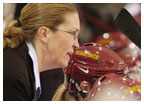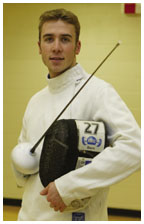February 9, 2005: Sports
On top, and still climbing
Laura Halldorson ’85 has high hopes for women’s hockey
Have sword, will travel
Olympic fencer’s skills have global appeal
Sports Scores — Updated weekly
Laura Halldorson ’85 coached Minnesota women’s hockey to an NCAA title in 2004. (Jerry Lee/University of Minnesota Athletics Depaertment) |
On
top, and still climbing
Laura Halldorson ’85 has high hopes for women’s
hockey
By Sheila Mulrooney Eldred
Back in those first years of women’s college hockey, when women got the buses without bathrooms and the locker rooms without lockers, Laura Halldorson ’85 was never one to let inequities go unnoticed.
As a freshman, the Princeton left wing surprised her teammates by telling then-men’s coach Jim Higgins that his players were infringing on the women’s ice time.
“I’m thinking, hey, the Zamboni should be out there — it should be our turn to get on the ice,” Halldorson recalls. “I just thought we should be treated fairly and the same as the men.”
Today, sitting in her sunny, corner office on the University of Minnesota’s campus, 20 years after she helped Princeton win three consecutive Ivy League titles, the 42-year-old coach of the Minnesota Golden Gophers is proud of the exponential growth women’s hockey has undergone. But, she says, there still is room for improvement.
Halldorson’s own success has followed the rise of women’s hockey, culminating in the Frozen Four championship last year. The victory represented more than the Gophers’ first NCAA title in women’s sports. When Halldorson arrived at Minnesota in 1996 after developing her coaching skills as an assistant at Princeton and a head coach at Colby College, there were no Division I women’s varsity hockey teams in the Midwest — or anywhere other than the East Coast.
That first season, the Gophers led the country in attendance; they continue to do so. And as the Gophers prepare to defend their national title next month, the Midwest has become the new powerhouse of the sport.
“You know,” Halldorson says, “growing up when I did we were teased a lot for playing hockey. Now at the high school level, at the youth level, and at the college level — especially here in Minnesota — it’s very accepted.”
Halldorson never dreamed she’d have the opportunity to play college hockey, much less coach it. She was prepared to play softball and volleyball at a Division III school before discovering that women’s hockey was being played at Division I schools on the East Coast.
“My dad called (then-Princeton coach) Bill Quackenbush, and I think he was very excited to hear there was someone from Minnesota who had played hockey for seven years,” Halldorson says. “At the time that was a lot of experience.”
When Halldorson joined Princeton’s varsity team in 1981, some of her teammates were converted figure skaters. But that didn’t stop the Tigers from dominating the Ivy League.
A psychology major at Princeton, Halldorson counts herself lucky to be among the few women making a living in hockey. As the only two women coaching Division I hockey, Halldorson and Brown coach Digit Murphy committed early on to doing all they could to advance the sport. “We’re in a position where we benefited from playing it,” Halldorson recalls thinking. “Let’s be part of improving the sport and the experience for the players.”
When women’s hockey became an NCAA championship sport, it was a gratifying moment for Halldorson, who helped the sport grow in earlier stints as chairwoman of the ECAC Women’s Ice Hockey Committee and president of the Women’s Hockey Coaches Association. She also serves on the committee for the Patty Kazmaier Award, the national player-of-the-year trophy named for a former teammate and member of the Class of 1986 who died from a rare blood disease in 1990.
Halldorson’s work for the good of the game has not taken away from her full-time job. Last year she was named the American Hockey Coaches Association’s Coach of the Year, and she aims to win more Frozen Four titles at Minnesota.
“That’s what our goal is every year,” Halldorson says.
“I’m not satisfied with just one moment in time.” ![]()
Sheila Mulrooney Eldred, a freelance journalist, lives in Minneapolis with her husband, Eric Sumner ’94.

After making history in Athens, Soren Thompson returned to compete as a senior at Princeton. (Beverly Schaefer) |
Have
sword, will travel
Olympic fencer’s skills have global appeal
Fencer Soren Thompson ’05 was 14 years old when he started making the trip: two hours each way, twice a week, from his home in San Diego to a training center in Los Angeles. Gago Demirchian, his longtime coach, was stunned to see a teenager so eager to sacrifice his time to study fencing.
“At first, I just admired his dedication to the sport,” Demirchian says. “When I started working with him, I saw the great talent he had.”
Nine years later, Thompson is still on the road, showing what he’s learned. He made history at the Olympics last summer, defeating second-seeded Alfredo Rota of Italy to become the first American to reach the men’s epee quarterfinals in nearly 50 years. With calculated strategy, an explosive style, and a 6'3" frame, Thompson ranks among the top three men’s epee fencers in the United States and stands 25th in the world rankings.
Thompson, an art and architecture major, is taking three classes this spring, in addition to completing his thesis on organic architecture and juggling a full fencing schedule with the Princeton team. But he still manages to find time to compete abroad and travel to New York City to train and spar. In each of the last two years, Thompson logged more than 100,000 air miles (he took the 2003—04 school year off to train for the Olympics), and in one hectic week in the spring of 2003 he competed at a tournament in Paris, returned to Princeton for three exams in three days, and jetted to another tournament in Tunisia. “I wouldn’t say it’s really fun,” he says of the travel, “but it doesn’t affect me too much.”
On the fencing strip, Thompson’s style combines the influences of a half-dozen coaches. Most fencers prefer to stick to one coach, but Thompson likes to take in an eclectic mix of suggestions and figure out which strategy works best against each opponent. “You’re matching everything you have against everything they have and looking to find a solution,” he says. “It’s very cerebral.”
Teammate Scott Sherman ’05, the Princeton captain, has seen Thompson’s problem-solving in action. Occasionally, an opponent will jump out to a lead against Thompson, but the success is usually fleeting. Like a chess player formulating a series of moves, Thompson plots his strategy and springs into action. “He adjusts and destroys,” Sherman says.
This year, Princeton’s epee squad of Thompson, junior Ben Solomon, and freshman Tommi Hurme is among the nation’s best, and the Tigers are looking to unseat Columbia, which has won the last three Ivy League championships. After college, Thompson plans to work in real estate in New York and continue fencing internationally.
Can Thompson be the first American to loosen Europe’s grip on
the epee world title? Demirchian, a former Armenian national champion,
won’t make any predictions, but he says the title is within reach.
“As I’ve always told him, there’s nothing he cannot
do,” he says. “There’s no one he cannot beat.”
![]()
By B.T.

Junior Sarah Butsch’s goal with 6:17 remaining in the third period helped WOMEN’S HOCKEY tie fifth-ranked New Hampshire on the road Jan. 1. A 3—2 loss to St. Lawrence on Jan. 7 ended the Tigers’ seven-game unbeaten streak, but they rebounded, shutting out Clarkson 3—0 on Jan. 8.
MEN’S HOCKEY beat American International College 4—2 on Jan. 4 behind two goals by Darroll Powe ’07. Goaltender Eric Leroux ’06 was one of 15 players nominated for the Hockey Humanitarian Award, a national honor that recognizes college players who devote time to community service.
Senior Justin Chiles’ victories in the 200-meter and 500-meter
freestyle races helped MEN’S SWIMMING
defeat Pittsburgh 141—102 at DeNunzio Pool Jan.
4. WOMEN’S SWIMMING
fell to Pittsburgh, 213—87. ![]()
By B.T.



